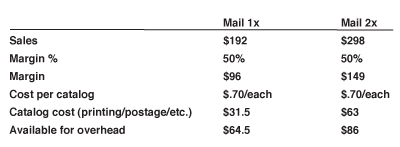Mailers often struggle with calculating how frequently they can profitably mail their buyer file and what frequency optimizes profitability. The following calculation is based on comparing two mailing frequencies.
First calculate the sales from two different mailing frequencies.

Then calculate the profitability of the alternative mailing frequencies.

In this example, the frequency of mailing two times generates $21.50 more profit than mailing a single time.
The issue is correctly estimating the sales per book of two different mailing frequencies. The accurate way to do this is to test alternate frequencies to measure the drop off in sales per book from more frequent mailings. Take sample buyer segments, split them into test cells, and mail half of the segment a single time and the other half of the segment twice and track the sales for each segment. Test a wide enough range of house file segments (from most recent buyers to oldest buyers) to estimate across the entire buyer file.
The test design to measure the difference in sales per book between mailing once and mailing twice is straightforward. Take enough segments and split them in half to get a series of comparisons across the buyer file. The best segments of the buyer file will respond differently than the marginal segments to increased frequency of mailing.
The second element of maximizing the profitability of the buyer file is to measure all house buyer segments and not mail any segments that fall below breakeven. If every buyer segment responds above breakeven, you are not losing money on any of the segments mailed. Of course, you should also include all buyer segments that will perform above breakeven.
But breakeven sales are not as simple to measure for buyers as for prospecting lists. While all the sales from prospecting lists can reasonably be allocated to the catalog’s circulation, only some of the sales from house buyers can be allocated to the catalog. Buyers tend to rebuy whether they receive a follow up catalog or not, so you need to know the incremental sales from each mailing and not count the underlying layer of sales that would have occurred even without a catalog. So breakeven for house buyers is higher than the breakeven sales per book for prospect lists. If a prospect list breaks even, even when it delivers $1.00/book and the buyer segment can reasonably be expected to yield $.30/book even if you don’t mail that segment a catalog, then breakeven for that house file segment is $1.00 + $.30 or $1.30. This higher number needs to be used when drawing the line for selecting buyer list segments for future mailing.
The test design for measuring true incremental sales is to split house buyer segments and match back the mail file and the order file to see the difference in sales between the buyers receiving a catalog and the holdout panel of buyers not receiving a mailing. This test design needs to be run over a series of mailings to track over time the behavior of buyers who don’t receive catalogs.
So if you mail all the segments that respond above breakeven and mail them as frequently as they can be mailed and still remain above breakeven, and forecast the higher breakeven of house buyer lists by only counting the incremental sales that each mailing delivers, your buyer should yield the maximum profitability. Suppose the maximum dollars of profits is not your goal and you’d rather have a higher profit percentage. What should you do to back off your circulation to achieve a higher profit percentage? Either drop the lower performing buyer segments, or cut back the mailing frequency and the buyer segments will be more profitable because you are not cutting off the tail of mailings with another buyer mailing.
Why would you want to work on your profit percentage rather than the maximum profit dollars?
- This strategy helps to lessen the financial risk of larger circulation mailings.
- Avoid boring your customers with another catalog remail of the same merchandise
- Reduce the risk of training your buyer file to expect promotions all the time.
- Lower chances of a static product mix that doesn’t change enough to justify more frequent mailings.
- Avoid the production demands of producing more and more frequent communications with customers.
To understand the relationship between profitability and the frequency of mailing your buyer file, you’ll need to:
- Measure the sales for each buyer segment
- Understand the tradeoffs in sales per book with different mailing frequencies.
- Calculate the underlying sales that occur regardless of catalog mailings and the incremental sales mailing a catalog.
- Know your breakeven sales per book for both prospecting and buyer file segments.
Knowing these elements allows you to calculate an optimal frequency schedule that maximizes your profitability or meets the financial objectives that drive your business.
Jim Coogan is president of Santa Fe, NM-based consultancy Catalog Marketing Economics.